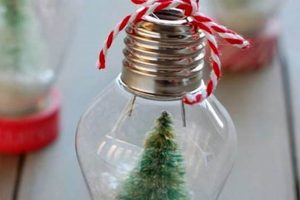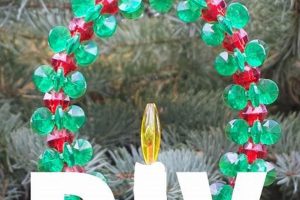Handcrafted decorations created from cloth offer a personalized approach to seasonal embellishment. These items, typically made at home, provide an alternative to mass-produced commercial decorations. For example, small stuffed shapes sewn from patterned cotton and hung on trees exemplify this crafting practice.
The practice of creating personalized decorations fosters creativity and allows for the expression of individual style. Historically, homemade adornments represented resourcefulness and a connection to family traditions. The use of fabric in crafting decorations enables a sustainable approach by utilizing repurposed materials and reducing reliance on commercially produced goods. This approach reduces waste and offers a cost-effective decorating solution.
The subsequent sections will explore various techniques involved in crafting these decorations, including fabric selection, pattern creation, and embellishment methods. Furthermore, different styles and construction approaches are examined to offer a comprehensive guide for creating unique and lasting decorative pieces.
DIY Fabric Ornaments
The following guidance facilitates the creation of aesthetically pleasing and structurally sound fabric decorations. Adherence to these principles enhances the final product and optimizes the crafting process.
Tip 1: Fabric Selection: Prioritize materials that complement the intended design. Woven cotton fabrics are easily manipulated and offer a diverse range of patterns. Felt provides structure without fraying, making it suitable for intricate shapes. Consider fabric weight and texture relative to the intended ornament size and complexity.
Tip 2: Pattern Precision: Employ accurate patterns to ensure consistent ornament shapes and sizes. Templates can be created from cardboard or purchased pre-made. Trace patterns onto the chosen fabric with accuracy, accounting for seam allowances where applicable.
Tip 3: Seam Reinforcement: Secure seams are essential for the durability of the decoration. Use a tight stitch, either by hand or machine, and reinforce stress points with backstitching. Consider using a serger for edge finishing to prevent fraying, especially when working with loosely woven fabrics.
Tip 4: Embellishment Considerations: Plan embellishments strategically to enhance the ornament’s visual appeal. Buttons, beads, embroidery, and paint can add texture and detail. Ensure embellishments are securely attached to prevent detachment with use.
Tip 5: Filling Techniques: When creating stuffed decorations, distribute filling evenly to avoid lumps and maintain the desired shape. Use a small amount of filling at a time, gradually adding more until the desired firmness is achieved. Polyester fiberfill is a commonly used and suitable option.
Tip 6: Hanging Mechanisms: Select a hanging mechanism that complements the ornament’s design and weight. Ribbon loops, twine, or metal hooks are commonly used. Attach the hanging mechanism securely to the ornament’s top, ensuring it can support the weight of the item without tearing.
Tip 7: Color Harmony: Employ a consistent color palette to create visually unified decorations. Consider the color scheme of the surrounding environment when selecting fabrics and embellishments. Complementary and analogous color schemes often provide a harmonious aesthetic.
Effective execution hinges upon careful planning and attention to detail. Adhering to the aforementioned principles results in robust and aesthetically pleasing fabric decorations.
The subsequent sections will delve into specific project ideas and advanced techniques for crafting unique fabric decorations.
1. Fabric Choice
Fabric selection represents a foundational aspect in the creation of handcrafted cloth decorations. The choice of material directly influences the ornament’s aesthetic qualities, durability, and ease of construction. Careful consideration of fabric properties is crucial for achieving desired results.
- Texture and Visual Appeal
The fabric’s texture significantly impacts the ornament’s tactile feel and visual interest. Smooth fabrics, such as satin, convey elegance, while textured fabrics, like burlap, offer a rustic aesthetic. The choice depends on the desired style and the overall decorative theme. For example, velvet might be chosen for a luxurious Christmas ornament, while cotton prints are suitable for more casual, whimsical designs.
- Durability and Longevity
Fabric durability determines the ornament’s ability to withstand handling and storage. Stronger fabrics, such as felt or tightly woven cotton, are less prone to tearing and wear. Consider the intended lifespan of the ornament; heirlooms intended for long-term use require robust materials. Delicate fabrics, like lace, may require reinforcement or protective linings.
- Ease of Manipulation and Sewing
The fabric’s properties affect its ease of manipulation during the crafting process. Some fabrics are easier to cut, sew, and shape than others. Felt, for instance, does not fray, simplifying the creation of clean edges. Slippery fabrics, such as silk, require careful handling and pinning to prevent shifting during sewing. The crafter’s skill level and available tools should influence fabric selection.
- Colorfastness and Washability
Colorfastness is crucial to prevent color bleeding or fading, especially if the ornament is intended for outdoor use or periodic cleaning. Washable fabrics allow for easy maintenance and prevent staining. Pre-washing fabrics before construction can mitigate shrinkage and color bleeding. Consider the potential for exposure to sunlight and moisture when selecting materials.
The interplay between fabric choice and these inherent properties shapes the character and longevity of fabric ornaments. Selecting appropriate materials is not merely a stylistic decision but a critical factor in ensuring the successful creation of durable and aesthetically pleasing decorations. The considered selection of materials elevates the crafting endeavor and the resulting final product.
2. Pattern Accuracy
Pattern accuracy constitutes a critical element in the successful fabrication of decorations from fabric. Deviations from precise measurements during pattern creation or transfer directly influence the final ornament’s shape, size, and overall aesthetic appeal. The cause-and-effect relationship is straightforward: inaccurate patterns yield distorted or asymmetrical results. For example, a pattern with inconsistent seam allowances will produce decorations where the edges do not align correctly, resulting in a visibly flawed product. The importance of pattern accuracy is thus underscored by its direct impact on the ornament’s fidelity to the intended design.
The practical significance of pattern accuracy extends beyond mere aesthetics. In the context of mass-producing ornaments, even minor discrepancies in the pattern can compound, leading to significant variations in the final product and potentially impacting production efficiency and material usage. For example, if cutting multiple layers of fabric from an inaccurate pattern, the cumulative error across layers could necessitate extensive trimming or even render some pieces unusable. Furthermore, when embellishments such as buttons or embroidery are designed to align with specific features of the pattern, inaccuracy can disrupt the planned design, requiring ad-hoc adjustments and compromising the ornament’s intended look.
In summary, the precision of patterns directly governs the quality and consistency of decorations crafted from fabric. Maintaining accuracy throughout the pattern-making and transfer processes is paramount. Challenges associated with pattern accuracy include the potential for human error during measurement and cutting, as well as the need for appropriate tools and techniques to ensure precise replication of the design. Recognizing and addressing these challenges links directly to broader themes of craftsmanship and quality control within the creation of decorations from fabric.
3. Stitch security
Stitch security directly influences the structural integrity and longevity of fabric decorations. The strength and durability of seams and embellishment attachments depend on the quality of the stitching. Inadequate stitch security leads to seam failure, detachment of embellishments, and ultimately, the deterioration of the finished ornament. For instance, a loosely sewn seam on a stuffed fabric heart can easily split open with handling, releasing the filling material and rendering the ornament unusable. Conversely, a securely stitched seam, reinforced at stress points, ensures the ornament withstands handling and retains its form over time. Therefore, the application of proper stitching techniques is not merely a cosmetic consideration but a fundamental aspect of crafting durable fabric ornaments.
The practical implications of stitch security extend to the choice of materials and construction methods. Thicker fabrics, such as felt, may require stronger threads and larger stitch lengths to ensure secure seams. Intricate designs with multiple fabric layers or delicate embellishments demand meticulous stitching to prevent distortion or damage. Consider a fabric ornament featuring delicate lace appliques; securing the lace with tiny, closely spaced stitches minimizes the risk of tearing the fragile material. Similarly, attaching heavy beads or buttons requires reinforcing stitches to prevent them from pulling away from the fabric. In all cases, prioritizing stitch security necessitates careful attention to detail and the use of appropriate tools, such as sturdy needles and durable thread.
In conclusion, stitch security is a critical determinant of the quality and lifespan of fabric ornaments. Its importance lies in its direct contribution to the structural integrity of seams and embellishments. The challenges associated with ensuring adequate stitch security can be mitigated through careful material selection, appropriate sewing techniques, and diligent attention to detail. Emphasizing this fundamental element elevates the craft of making fabric ornaments and aligns with the broader theme of producing durable, aesthetically pleasing, and lasting decorative items.
4. Embellishment integration
Embellishment integration represents a critical phase in the creation of handcrafted fabric adornments. The effective incorporation of decorative elements elevates a simple construction to a visually appealing and personalized work. Inadequate execution, however, detracts from the ornament’s overall aesthetic. For instance, consider a basic felt star; the addition of carefully selected beads, sequins, or embroidery transforms this simple shape into a festive and intricate decoration. Conversely, poorly chosen or haphazardly applied embellishments can result in a cluttered or unbalanced appearance. The degree to which embellishments complement and enhance the ornament’s core design determines the success of this phase.
The practical significance of embellishment integration extends beyond mere aesthetic enhancement. Strategic placement of embellishments reinforces structural integrity. For example, securing the edges of layered fabric pieces with decorative stitching not only enhances visual appeal but also prevents fraying and improves the ornament’s durability. Consider also the application of dimensional fabric paint; this technique adds visual texture and reinforces the fabric surface, improving its resistance to wear and tear. Careful planning and precise execution when incorporating decorative elements increases the perceived value of the hand-crafted work and ensures it withstands handling and storage. Moreover, a well-executed application of embellishments ensures visual harmony and is aligned with intended use of the ornament.
In summary, the integration of embellishments is a vital step that shapes fabric ornaments. Its importance resides in its capacity to elevate aesthetic appeal and reinforce structural qualities. Addressing the challenges associated with achieving seamless embellishment integration requires careful planning, mindful selection of materials, and precise application. Successfully integrating embellishments within fabric adornments enhances the artistic achievement and underscores the broader theme of meticulous craftsmanship.
5. Filling distribution
The uniform allocation of filling material within crafted fabric adornments directly influences the ornament’s shape, texture, and overall aesthetic quality. Uneven distribution results in distorted forms, lumpiness, and a compromised tactile experience. The effect of poor filling distribution is readily apparent in a stuffed ornament: inconsistencies in density create unsightly bulges or collapses, detracting from the intended design. For example, a fabric snowman with excess filling in its base will be unstable and visually unbalanced, diminishing its aesthetic appeal and functionality as a decorative item. The even dispersal of filling ensures a smooth, consistent surface and maintains the designed shape, contributing to the final piece’s visual integrity.
Proper filling distribution enhances the practical application of crafted fabric adornments. Consistent density provides structural support, preventing sagging or deformation over time. This is particularly important for ornaments that incorporate intricate details or delicate fabrics. Even stuffing supports design elements, such as embroidered details, and safeguards delicate fabrics from excessive tension. The implementation of effective filling techniques, such as using small amounts of filling and gradually building up density, ensures uniform support and minimizes the risk of distortion. Furthermore, careful selection of filling materials based on their weight, loft, and compressibility contributes to optimal filling distribution.
In summary, the proper distribution of filling within fabric ornaments is a critical factor influencing their aesthetic appeal, structural integrity, and overall quality. Challenges associated with achieving uniform density can be mitigated through the application of meticulous filling techniques and thoughtful material selection. Emphasizing this often-overlooked aspect of fabrication enhances the finished product and aligns with the broader theme of skillful and deliberate crafting.
6. Hanging Support
The secure and aesthetically appropriate suspension of handcrafted fabric adornments constitutes a crucial, yet often underappreciated, element of their design and functionality. The means by which these items are hung directly impacts their presentation and longevity. Selection and implementation of appropriate hanging support mechanisms are therefore essential for maximizing the visual impact and ensuring the durable display of fabric ornaments.
- Weight Distribution and Load Capacity
The hanging mechanism must be capable of supporting the ornament’s weight without tearing or deforming the fabric. Heavier ornaments require stronger hanging solutions, such as reinforced ribbon loops or durable metal hooks. The distribution of weight across the hanging point is also crucial; an uneven distribution can cause the ornament to tilt or hang improperly. Failure to account for weight and load capacity results in damage to the ornament or its detachment from the hanging point.
- Material Compatibility and Aesthetic Harmony
The choice of hanging material should complement the ornament’s overall design and style. For example, a rustic fabric ornament might benefit from a twine or hemp cord hanger, while a more elegant ornament could utilize a satin ribbon or delicate chain. The hanging support should enhance, rather than detract from, the ornament’s visual appeal. Incompatibility in materials and aesthetics undermines the cohesive presentation of the crafted piece.
- Attachment Security and Durability
The method of attaching the hanging support to the ornament must be secure and durable enough to withstand repeated handling and potential stress. Sewn loops should be reinforced with multiple stitches, and glued attachments should utilize a strong adhesive suitable for fabric. Insufficiently secured hanging mechanisms pose a risk of detachment, potentially damaging the ornament or the surrounding environment. Permanence and resistance to wear and tear are paramount considerations.
- Hanging Angle and Display Orientation
The placement and angle of the hanging support influence the ornament’s display orientation. Properly positioned loops or hooks ensure that the ornament hangs straight and presents its most visually appealing side. Misaligned or improperly attached hangers can cause the ornament to tilt or rotate, disrupting its intended presentation. Careful consideration of the hanging angle is necessary for achieving the desired display effect.
These diverse factors relating to hanging support collectively determine the effectiveness and visual appeal of fabric ornaments. The integration of a robust and aesthetically fitting suspension system directly enhances the overall quality and presentation of these handcrafted items, ensuring their lasting beauty and functionality.
7. Color harmony
Color harmony significantly influences the aesthetic success of handcrafted fabric decorations. The purposeful arrangement of colors within an ornament directly affects its visual appeal and its ability to integrate cohesively within a given environment. A poorly conceived color scheme detracts from the craft object’s perceived value, while a harmonious palette enhances its beauty and creates a sense of visual unity. For example, a Christmas tree ornament employing a limited range of analogous colors, such as varying shades of green and gold, presents a calming and sophisticated appearance. Conversely, an ornament composed of clashing and discordant colors may appear visually jarring and unappealing, diminishing its decorative impact. Thus, color harmony’s influence is pivotal to fabric ornament design.
The practical applications of understanding color harmony in the context of these handcrafted pieces are manifold. Effective color selection can evoke specific emotions or create desired atmospheres. Warm color combinations, such as reds and oranges, impart a sense of cheerfulness and energy, suitable for festive occasions. Cool color palettes, such as blues and greens, convey tranquility and serenity, appropriate for ornaments intended for more subdued settings. In addition, employing color theory principles, such as complementary color pairings, can create visual interest and highlight specific design elements within the ornament. For instance, using a small accent of red against a predominantly green background draws the eye and creates a focal point. Therefore, informed color choice enables the artist to control the ornament’s emotional impact and visual effectiveness.
In summary, color harmony is a critical element that determines the visual success of decorations crafted from fabric. Its impact is evident in the ornament’s aesthetic appeal and its ability to complement its surroundings. Challenges associated with achieving color harmony can be addressed through the application of color theory principles and mindful selection of materials. Ultimately, prioritizing color harmony enhances the artistic merit of these handcrafted items and aligns with the broader goal of creating aesthetically pleasing and visually unified decorative pieces.
Frequently Asked Questions
The following addresses common inquiries regarding the construction and maintenance of handcrafted fabric ornaments. Information presented aims to clarify best practices and dispel prevalent misconceptions.
Question 1: What fabric types are most suitable for crafting durable ornaments?
Woven cotton, felt, and linen offer structural integrity and ease of manipulation. Tightly woven fabrics are generally more resistant to tearing and fraying, contributing to the ornament’s longevity. The selection should align with the ornament’s intended design and level of complexity.
Question 2: How can one prevent fraying on fabric edges without using a sewing machine?
Pinking shears, fabric glue, or fusible interfacing provide effective edge finishing. Pinking shears create a zigzag cut that minimizes fraying. Fabric glue seals the edges, preventing unraveling. Fusible interfacing, when ironed onto the fabric’s edge, provides added stability and prevents fraying.
Question 3: What is the recommended method for achieving symmetrical ornament shapes?
Employing accurate patterns and precise cutting techniques is essential. Templates created from cardboard or purchased pre-made ensure consistent shapes. Tracing patterns onto fabric with a fine-point marker and cutting along the traced lines with sharp scissors maximizes precision.
Question 4: How can one ensure embellishments remain securely attached to fabric ornaments?
Employing durable thread and reinforcing stitches at stress points is critical. Hand-sewing embellishments with multiple passes of thread and securing the ends with knots provides added security. Fabric glue or fusible webbing can be used in conjunction with stitching for added reinforcement.
Question 5: What is the best practice for cleaning fabric ornaments without damaging them?
Spot cleaning with a damp cloth and mild detergent is generally recommended. Avoid immersing fabric ornaments in water, as this can cause damage or distortion. For delicate ornaments, dry cleaning may be a suitable option.
Question 6: How does one store fabric ornaments to prevent damage and maintain their appearance?
Storing fabric ornaments in a cool, dry place away from direct sunlight protects against fading and deterioration. Wrapping ornaments individually in acid-free tissue paper or placing them in a padded storage container minimizes abrasion and prevents damage.
Adherence to these guidelines enhances the quality and longevity of handcrafted fabric ornaments. Thoughtful construction and maintenance practices preserve their aesthetic appeal and structural integrity.
The subsequent section will provide instructions for specific fabric ornament projects.
DIY Fabric Ornaments
This exploration of diy fabric ornaments has underscored the importance of material selection, pattern precision, secure construction, and thoughtful embellishment. The crafting process demands attention to detail and adherence to sound techniques. Successfully executed, these projects yield personalized, enduring decorations.
The pursuit of fabric ornament creation offers an avenue for creative expression and sustainable practice. The value inherent in these handcrafted items lies not only in their aesthetic appeal but also in the dedication invested in their making. Continued refinement of skills and exploration of innovative designs will further enhance the legacy of fabric ornament artistry.







